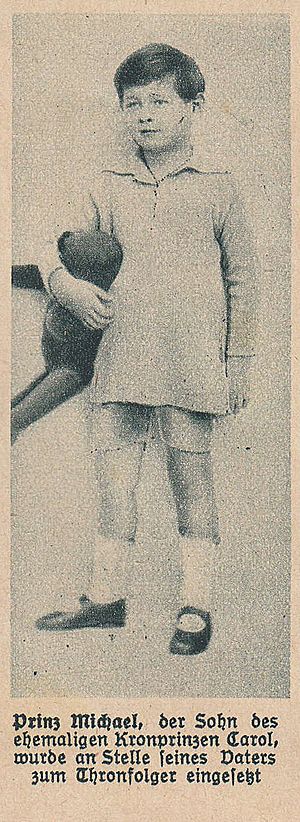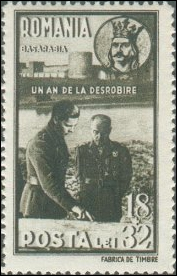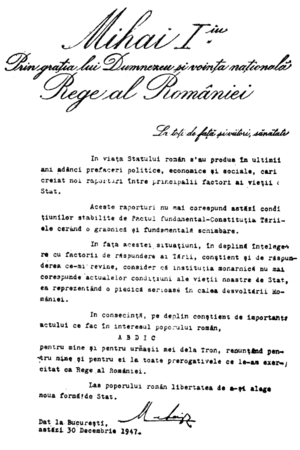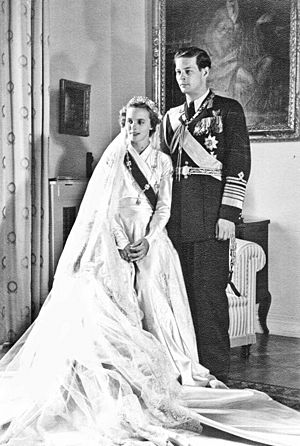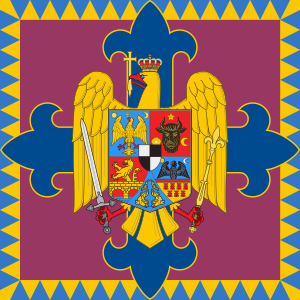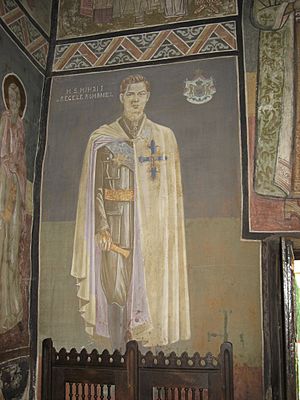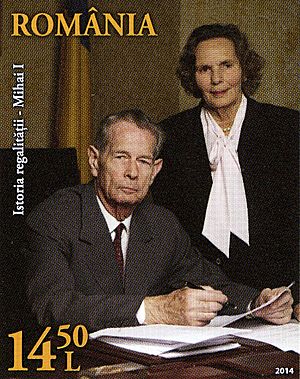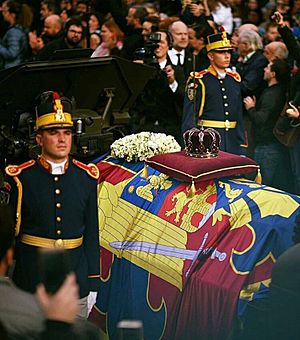Michael I of Romania facts for kids
Quick facts for kids Michael I |
|
|---|---|
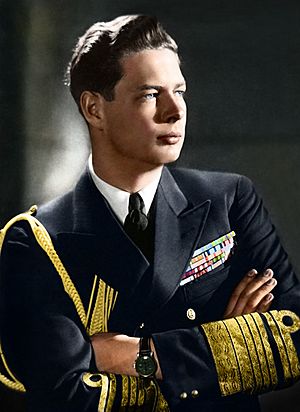
Michael I in 1947
|
|
| King of Romania | |
| First reign | 20 July 1927 – 8 June 1930 |
| Predecessor | Ferdinand I |
| Successor | Carol II |
| Regents |
See list
Prince Nicholas (1927–1930)
Miron Cristea (1927–1930) Gheorghe Buzdugan (1927–1929) Constantin Sărăţeanu (1929–1930) |
| Second reign | 6 September 1940 – 30 December 1947 |
| Predecessor | Carol II |
| Successor | Monarchy abolished |
| Coronation | 6 September 1940 |
| Born | 25 October 1921 Peleș Castle, Sinaia, Kingdom of Romania |
| Died | 5 December 2017 (aged 96) Aubonne, Vaud, Switzerland |
| Burial | 16 December 2017 Royal Cathedral, Curtea de Argeș Monastery, Curtea de Argeș, Romania |
| Spouse | |
| Issue |
|
| House |
|
| Father | Carol II of Romania |
| Mother | Princess Helen of Greece and Denmark |
| Religion | Romanian Orthodox |
| Signature | |
Michael I (Romanian: Mihai I [miˈhaj]; 25 October 1921 – 5 December 2017) was the last king of Romania. He ruled twice: first from 1927 to 1930, and then again from 1940 until he was forced to give up his throne in 1947.
Michael became king for the first time when he was very young, after his grandfather, King Ferdinand I, passed away. Because Michael was still a child, a group of people called a regency council helped him rule. Later, his father, Crown Prince Carol, returned to Romania and became king instead.
In 1940, Carol II was forced to leave the throne, and Michael became king again. During this time, Romania was allied with Nazi Germany under a military leader named Ion Antonescu. In 1944, Michael helped remove Antonescu from power and joined the Allied forces in World War II. After the war, Michael was forced to give up his throne by the new Communist government in 1947. He then lived in exile, mostly in Switzerland.
After the Communist rule ended in Romania in 1989, Michael was able to return to his home country. He was welcomed by many people and worked to help Romania join groups like NATO and the European Union.
Contents
Early Life as a Prince
Michael was born in 1921 at Foișor Castle in Sinaia, Romania. His parents were Crown Prince Carol and Crown Princess Elena. His grandfather was the reigning King Ferdinand I.
When Michael was only four years old, his father, Carol, gave up his right to the throne and moved away. This meant that Michael became the next in line to be king. When King Ferdinand died in 1927, Michael became king just before his sixth birthday.
Michael's Time as King
First Reign and the Return of Carol II
When Michael became king in 1927, he was only five years old. So, a group of people, including his uncle Prince Nicolae, helped him rule. This group was called a regency.
In 1930, Michael's father, Carol, came back to Romania. Many politicians were unhappy with the regency, especially during the Great Depression. So, Carol was made king, and Michael became the crown prince again. He was also given the special title "Grand Voivode of Alba Iulia".
Second Reign and World War II
In September 1940, Michael's father, Carol II, was forced to give up the throne. Michael, who was then 18 years old, became king again. At this time, Romania was led by a military dictator named Marshal Ion Antonescu. Under Antonescu, Romania became allied with Nazi Germany during World War II.
Even though Michael was king, Antonescu held most of the power. Michael was mainly a symbolic leader until 1944. He met with leaders like Adolf Hitler and Benito Mussolini during this time.
Turning Against Nazi Germany
By 1944, the war was not going well for Germany. On August 23, 1944, King Michael worked with politicians and army officers to remove Antonescu from power. Michael ordered Antonescu's arrest.
On the same night, Michael announced on the radio that Romania was stopping its fight against the Red Army and joining the Allies. He also declared war on Germany. This action helped shorten World War II and saved many lives.
After the war, King Michael received important awards. He was given the highest award from the United States, the Legion of Merit, by President Harry S. Truman. He also received the Soviet Order of Victory from Joseph Stalin for his brave decision to switch sides.
Rule Under Communist Pressure
In March 1945, Michael was forced to appoint a government led by Petru Groza, who was supported by the Soviet Union. For the next two years, Michael had very little real power.
From August 1945 to January 1946, Michael tried to resist the Communist government. He refused to sign their new laws, hoping to make them resign. This was known as the "royal strike." However, under pressure from the Soviet Union, Britain, and America, Michael eventually stopped his opposition.
Forced to Leave the Throne
In November 1947, King Michael went to London for a royal wedding. There, he met Princess Anne of Bourbon-Parma, who would later become his wife. Michael decided to return to Romania, even though the British Ambassador advised him not to.
On December 30, 1947, Michael was called back to Bucharest. When he arrived at his palace, he found it surrounded by soldiers loyal to the Communists. Groza and the Communist leader Gheorghe Gheorghiu-Dej demanded that Michael sign a paper giving up his throne. Michael had no choice but to sign the document.
Later that day, the Communist government announced that Romania was no longer a monarchy and was now a "People's Republic." On January 3, 1948, Michael was forced to leave Romania. He was the last king behind the Iron Curtain to lose his throne.
Michael later said that he was threatened with violence against students if he did not sign the abdication. He also said that he was allowed to leave with only a few personal cars.
Marriage and Family
Meeting Anne and Engagement
In November 1947, Michael met Princess Anne of Bourbon-Parma in London. She was there for the wedding of Michael's cousins, Princess Elizabeth (who would become Queen Elizabeth II) and Prince Philip.
Michael and Anne quickly fell in love. After only sixteen days, Michael proposed to Anne in Switzerland, and she accepted. However, when Michael returned to Romania, the Communist government told him that a wedding announcement was "not a good idea." Soon after, he was forced to give up his throne. Anne was unable to get news of him until he left the country. They finally met again in Switzerland in January 1948.
Their Wedding
Anne was Catholic, and Michael was Orthodox. The Catholic Church required a special permission for her to marry a non-Catholic. Michael refused to promise that their children would be raised Catholic, as this would go against Romania's constitution and hurt any chance of him returning to the throne. The Pope refused to give the permission.
Despite this, Michael and Anne decided to get married. Their wedding took place on June 10, 1948, in Athens, Greece. The ceremony was held in the Royal Palace. Many royal guests attended, but Michael's father, Carol, was not invited.
Even though the Catholic Church did not recognize their first wedding, it was legal everywhere else. They later had another religious ceremony in a Catholic church in Monaco in 1966.
Their Children
Michael and Anne had five daughters:
- Margareta, Custodian of the Crown of Romania (born 1949)
- Princess Elena of Romania (born 1950)
- Princess Irina of Romania (born 1953)
- Princess Sophie of Romania (born 1957)
- Princess Maria of Romania (born 1964)
They also had five grandchildren and five great-grandchildren.
Life in Exile
After leaving Romania, Michael and Anne lived in different places, including Italy, Switzerland, and England. In 1948, the Communist government took away Michael's Romanian citizenship.
During his time in exile, Michael worked various jobs to support his family. He was a farmer, a pilot, an entrepreneur, and even a stockbroker. He and Anne lived in Switzerland for 45 years.
Return to Romania
On December 25, 1990, a year after the Communist rule ended in Romania, Michael returned to his home country for the first time in 43 years. He wanted to visit the tombs of his ancestors. However, he was stopped by the police and forced to leave the country.
In 1992, the Romanian government allowed Michael to visit for Easter. He was greeted by huge crowds. A speech he gave in Bucharest attracted over a million people. Because of his popularity, the government at the time did not allow him to visit again for several years.
In 1997, after a new president was elected, Michael's Romanian citizenship was given back to him, and he was allowed to visit Romania freely. He then divided his time between Switzerland and Romania. Some of his family's former homes, like Peleș Castle and Săvârșin Castle, were returned to them. Peleș and Pelișor Castles are now open to the public.
-
Elisabeta Palace, Bucharest
-
Peleș Castle, Sinaia
-
Săvârșin Castle, Arad County
Later Years and Legacy
Michael believed that the Romanian people should decide if they wanted the monarchy back. He said, "If the people want me to come back, of course, I will come back." He wanted Romanians to understand the history and value of the monarchy.
He also took on some diplomatic roles for Romania. In 1997 and 2002, he traveled around Western Europe, encouraging countries to support Romania's entry into NATO and the European Union.
In 2010, Michael participated in the Victory Parade in Moscow. He was the only living Supreme Commander-in-Chief from a European country in World War II.
As he grew older, Michael became very popular in Romania. On his 90th birthday in 2011, he gave a speech to the Romanian Parliament. A survey in 2012 showed that he was the most trusted public figure in Romania.
On August 1, 2016, his wife, Queen Anne, passed away at the age of 92.
Health and Passing
On March 2, 2016, the Royal Council announced that King Michael was stepping back from public life due to health issues. His daughter, Crown Princess Margareta, took over his public duties. Michael was diagnosed with leukemia and epidermoid carcinoma and received treatment.
King Michael I passed away on December 5, 2017, at his home in Switzerland. He was 96 years old. His youngest daughter, Princess Maria, was with him.
Funeral
On December 13, 2017, King Michael I's coffin was brought back to Romania. It was first taken to Peleș Castle and then to the Royal Palace for people to pay their respects.
King Michael I was buried on December 16, 2017, with full state honors. He was laid to rest in the Royal Family Mausoleum at the Curtea de Argeș Cathedral, next to his wife, Queen Anne. Many foreign royals attended the funeral, including King Emeritus Juan Carlos I of Spain, King Carl XVI Gustaf of Sweden, and Prince Charles (now King Charles III) from the United Kingdom.
His funeral was one of the largest in Romania, with nearly a million Romanians coming to Bucharest to honor him.
Line of Succession
According to the old Romanian constitution, if King Michael had no sons, the right to the throne would pass to the Hohenzollern family in Germany. However, in 2007, King Michael signed a document naming his eldest daughter, Princess Margareta, as his heir. This document does not have legal power today, as Romania is a republic.
In 2011, Michael officially cut ties with the German Hohenzollern family and changed his family's name to "of Romania." He also gave up any princely titles from the German Hohenzollerns.
In 2015, Michael removed his grandson, Nicholas Medforth-Mills, from the line of succession. He hoped Nicholas would find other ways to serve Romania.
Personality and Interests
When Michael was 16, he was involved in a driving accident where a bicyclist died. This event was kept quiet at the time.
Michael was the head of the Romanian Boy Scouts in the 1930s. He loved cars, especially military jeeps. He was also very interested in airplanes and worked as a test pilot during his exile.
After World War II, Michael became interested in a movement called Moral Rearmament. He found comfort and hope in this movement after losing his country.
Honours and Awards
 Belgium: Knight Grand Cross of the Order of Leopold I
Belgium: Knight Grand Cross of the Order of Leopold I Czechoslovakia: Grand Cross with Collar of the Order of the White Lion
Czechoslovakia: Grand Cross with Collar of the Order of the White Lion Czech Republic: Recipient of the Medal of Merit of the Ministry of Defence, 1st Class
Czech Republic: Recipient of the Medal of Merit of the Ministry of Defence, 1st Class Denmark: Recipient of the Royal Medal of Recompense, Special Class
Denmark: Recipient of the Royal Medal of Recompense, Special Class Finland: Grand Cross with Collar of the Order of the White Rose
Finland: Grand Cross with Collar of the Order of the White Rose- France
 France: Grand Cross of the Order of the Legion of Honour
France: Grand Cross of the Order of the Legion of Honour House of Orléans: Knight Grand Cross with Collar of the Order of Saint Lazarus
House of Orléans: Knight Grand Cross with Collar of the Order of Saint Lazarus
 Greek Royal Family: Knight Grand Cross of the Royal Order of the Redeemer
Greek Royal Family: Knight Grand Cross of the Royal Order of the Redeemer Greek Royal Family: Knight Grand Cross with Collar of the Royal Order of Saints George and Constantine
Greek Royal Family: Knight Grand Cross with Collar of the Royal Order of Saints George and Constantine Greek Royal Family: Knight Grand Cross of the Royal Order of George I
Greek Royal Family: Knight Grand Cross of the Royal Order of George I Greek Royal Family: Knight of the Royal Decoration of the Greek Royal House, Special Class
Greek Royal Family: Knight of the Royal Decoration of the Greek Royal House, Special Class Greek Royal Family: Recipient of the Centenary Medal of the Kingdom of Greece
Greek Royal Family: Recipient of the Centenary Medal of the Kingdom of Greece Italian Royal Family: Knight of the Royal Supreme Order of the Most Holy Annunciation
Italian Royal Family: Knight of the Royal Supreme Order of the Most Holy Annunciation Italian Royal Family: Knight Grand Cross of the Royal Order of Saints Maurice and Lazarus
Italian Royal Family: Knight Grand Cross of the Royal Order of Saints Maurice and Lazarus Italian Royal Family: Knight Grand Cross the Royal Order of the Crown
Italian Royal Family: Knight Grand Cross the Royal Order of the Crown
 Sovereign Military Order of Malta: Bailiff Knight Grand Cross with Collar of Honour and Devotion of the Sovereign Military Order of Malta
Sovereign Military Order of Malta: Bailiff Knight Grand Cross with Collar of Honour and Devotion of the Sovereign Military Order of Malta
 Poland: Grand Cross of the Order of the White Eagle
Poland: Grand Cross of the Order of the White Eagle- Russia
 Soviet Union: Member of the Order of Victory
Soviet Union: Member of the Order of Victory Russia: Recipient of the 60 Years of Victory in the Great Patriotic War of 1941–1945 Commemorative Jubilee Medal
Russia: Recipient of the 60 Years of Victory in the Great Patriotic War of 1941–1945 Commemorative Jubilee Medal
- Serbia
 Serbian Royal Family: Knight Grand Cross of the Royal Order of the Star of Karađorđe
Serbian Royal Family: Knight Grand Cross of the Royal Order of the Star of Karađorđe Serbian Royal Family: Knight Grand Cross of the Royal Order of Saint Sava
Serbian Royal Family: Knight Grand Cross of the Royal Order of Saint Sava Republic of Serbia: Recipient of the Military Virtue Medal
Republic of Serbia: Recipient of the Military Virtue Medal
 Sweden: Recipient of the 50th Birthday Medal of King Carl XVI Gustaf
Sweden: Recipient of the 50th Birthday Medal of King Carl XVI Gustaf United Kingdom: Honorary Knight Grand Cross of the Royal Victorian Order
United Kingdom: Honorary Knight Grand Cross of the Royal Victorian Order United Kingdom: Recipient of the King George VI Coronation Medal
United Kingdom: Recipient of the King George VI Coronation Medal United States: Chief Commander of the Legion of Merit
United States: Chief Commander of the Legion of Merit
Awards
National awards
 Romania: Honorary Citizen of Călărași County
Romania: Honorary Citizen of Călărași County Romania: Honorary Citizen of the City of Techirghiol (in Constanța county)
Romania: Honorary Citizen of the City of Techirghiol (in Constanța county) Romania: Honorary Citizen of the City of Craiova
Romania: Honorary Citizen of the City of Craiova Romania: Honorary Citizen of the Village of Stremț (in Alba county)
Romania: Honorary Citizen of the Village of Stremț (in Alba county) Romania: Honorary Degree from the Bucharest University of Economic Studies
Romania: Honorary Degree from the Bucharest University of Economic Studies Romania: Honorary Degree from the University of Agronomic Sciences and Veterinary Medicine (in Bucharest)
Romania: Honorary Degree from the University of Agronomic Sciences and Veterinary Medicine (in Bucharest) Romania: Honorary Degree from the Dimitrie Cantemir Christian University (in Bucharest)
Romania: Honorary Degree from the Dimitrie Cantemir Christian University (in Bucharest) Romania: Honorary Degree from the Politehnica University of Bucharest
Romania: Honorary Degree from the Politehnica University of Bucharest Romania: Honorary Degree from the University of Pitești
Romania: Honorary Degree from the University of Pitești Romania: Honorary Degree from the University of Bucharest
Romania: Honorary Degree from the University of Bucharest Romania: Honorary Degree from the Victor Babeș University of Medicine and Pharmacy, Timișoara
Romania: Honorary Degree from the Victor Babeș University of Medicine and Pharmacy, Timișoara Romania: Honorary Degree from the Polytechnic University of Timișoara
Romania: Honorary Degree from the Polytechnic University of Timișoara Romania: Honorary Degree from the University of Agricultural Sciences and Veterinary Medicine of Cluj-Napoca
Romania: Honorary Degree from the University of Agricultural Sciences and Veterinary Medicine of Cluj-Napoca Romania: Honorary Degree from the Carol I National Defence University (in Bucharest)
Romania: Honorary Degree from the Carol I National Defence University (in Bucharest) Romania: Honorary Degree from the Alexandru Ioan Cuza University (in Iași)
Romania: Honorary Degree from the Alexandru Ioan Cuza University (in Iași) Romanian Jewish community: Recipient of the Alexandru Șafran Medal
Romanian Jewish community: Recipient of the Alexandru Șafran Medal
Foreign awards
 Czech Republic: Honorary Citizen of the City of Kroměříž
Czech Republic: Honorary Citizen of the City of Kroměříž
 Prague:
Prague:
- Prague Society for International Cooperation: Sixth Recipient of the Hanno R. Ellenbogen Citizenship Award
 United Kingdom: Freeman of the City of London
United Kingdom: Freeman of the City of London United Kingdom: Liveryman of the Worshipful Company of Wax Chandlers
United Kingdom: Liveryman of the Worshipful Company of Wax Chandlers
Military Ranks
 Marshal of the Romanian Armed Forces
Marshal of the Romanian Armed Forces
 Supreme Commander–in–Chief General of the Romanian Land Forces
Supreme Commander–in–Chief General of the Romanian Land Forces Supreme Commander–in–Chief General of the Romanian Air Force
Supreme Commander–in–Chief General of the Romanian Air Force Supreme Commander–in–Chief Admiral of the Romanian Naval Forces
Supreme Commander–in–Chief Admiral of the Romanian Naval Forces
Places Named After Michael I
 Romania
Romania
 House of Romania: King Michael I Medal for Loyalty
House of Romania: King Michael I Medal for Loyalty Bucharest:
Bucharest:
- King Michael I Park
- King Michael I Boulevard
- King Michael I Square
- King Michael I High School
- King Michael I Railway Technical College
- Banat: King Michael I Banat University of Agricultural Sciences and Veterinary Medicine
- Curtea de Argeș: King Michael I Technological High School
- Drobeta-Turnu Severin: King Michael I High School
- Pucioasa: King Michael I Technical High School
- Săvârșin: King Michael I Technological High School
 Moldova
Moldova
- Cimișeni: King Michael I High School
Statues and Monuments
On October 25, 2012, a large statue of Michael, including a bronze bust, was unveiled in King Michael I Square in Bucharest. Michael himself attended the event.
On October 25, 2021, another statue of Michael was unveiled in the town of Sinaia. Many important people, including the Romanian Minister of Culture and Princess Margareta, were there.
See also
 In Spanish: Miguel I de Rumania para niños
In Spanish: Miguel I de Rumania para niños


